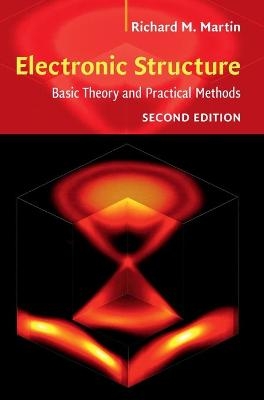
Electronic Structure
Cambridge University Press (Verlag)
978-1-108-42990-0 (ISBN)
The study of electronic structure of materials is at a momentous stage, with new computational methods and advances in basic theory. Many properties of materials can be determined from the fundamental equations, and electronic structure theory is now an integral part of research in physics, chemistry, materials science and other fields. This book provides a unified exposition of the theory and methods, with emphasis on understanding each essential component. New in the second edition are recent advances in density functional theory, an introduction to Berry phases and topological insulators explained in terms of elementary band theory, and many new examples of applications. Graduate students and research scientists will find careful explanations with references to original papers, pertinent reviews, and accessible books. Each chapter includes a short list of the most relevant works and exercises that reveal salient points and challenge the reader.
Richard M. Martin is Emeritus Professor of Physics at the University of Illinois Urbana-Champaign and Adjunct Professor of Applied Physics at Stanford University. He has made important contributions to many areas of modern electronic structure, including over 200 papers and is a co-author of another major book in the field, Interacting Electrons: Theory and Computational Approaches. (Cambridge University Press, 2016)
Preface; Acknowledgments; Notation; Part I. Overview and background topics: 1. Introduction; 2. Overview; 3. Theoretical background; 4. Periodic solids and electron bands; 5. Uniform electron gas and sp-bonded metals; Part II. Density functional theory: 6. Density functional theory: foundations; 7. The Kohn–Sham auxiliary system; 8. Functionals for exchange and correlation I; 9. Functionals for exchange and correlation II; Part III. Important preliminaries on atoms: 10. Electronic structure of atoms; 11. Pseudopotentials; Part IV. Determination of electronic structure: the basic methods: 12. Plane waves and grids: basics; 13. Plane waves and real space methods: full calculations; 14. Localized orbitals: tight-binding; 15. Localized orbitals: full calculations; 16. Augmented functions: APW, KKR, MTO; 17. Augmented functions: linear methods; 18. Locality and linear scaling O(N) methods; Part V. From Electronic Structure to Properties of Matter: 19. Quantum molecular dynamics (QMD); 20. Response functions: phonons, magnons, . . .; 21. Excitation spectra and optical properties; 22. Surfaces, interfaces, and lower dimensional systems; 23. Wannier functions; 24. Polarization, localization, and Berry phases; Part VI. Electronic Structure and Topology: 25. Topology of the electronic structure of a crystal: introduction; 26. Two band models: Berry phase, winding and topology; 27. Topological insulators I: Two dimensions; 28. Topological insulators II: Three dimensions; Part VII. APPENDICES: A. Functional equations; B. LSDA and GGA functionals; C. Adiabatic approximation; D. Perturbation Theory, response functions and Green's functions; E. Dielectric functions and optical properties; F. Coulomb interactions in extended systems; G. Stress from electronic structure; H. Energy and stress densities; I. Alternative force expressions; J. Scattering and phase shifts; K. Useful relations and formulas; L. Numerical methods; M. Iterative methods in electronic structure; N. Two-center matrix elements: expressions for arbitrary angular momentum l; O. Dirac equation and spin-orbit interaction; P. Berry phase, curvature and Chern numbers; Q. Quantum Hall effect and edge conductivity; R. Codes for electronic structure calculations for solids; References; Index.
| Erscheinungsdatum | 03.08.2020 |
|---|---|
| Zusatzinfo | Worked examples or Exercises; 7 Tables, black and white; 43 Halftones, black and white; 165 Line drawings, black and white |
| Verlagsort | Cambridge |
| Sprache | englisch |
| Maße | 178 x 250 mm |
| Gewicht | 1630 g |
| Themenwelt | Mathematik / Informatik ► Mathematik ► Angewandte Mathematik |
| Naturwissenschaften ► Chemie ► Physikalische Chemie | |
| Naturwissenschaften ► Physik / Astronomie ► Festkörperphysik | |
| ISBN-10 | 1-108-42990-4 / 1108429904 |
| ISBN-13 | 978-1-108-42990-0 / 9781108429900 |
| Zustand | Neuware |
| Informationen gemäß Produktsicherheitsverordnung (GPSR) | |
| Haben Sie eine Frage zum Produkt? |
aus dem Bereich


